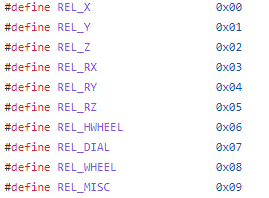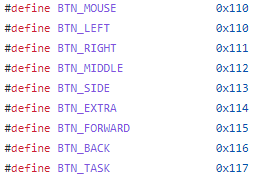目录
一、概述
二、结构体字段解析
三、不同类型地解释字段
3.1 鼠标事件
3.2 键盘事件
3.3 触摸屏事件
四、使用struct input_event读取设备文件的例子
一、概述
Linux系统是通过输入子系统来管理输入设备(如鼠标、键盘、触摸屏、游戏摇杆)的。配置了内核支持且安装对应驱动后,当系统接入输入设备,会在/dev/input下生成对应设备文件,下图是鼠标、键盘在不同情况下/dev/input的设备文件。

当输入设备有事件产生时,内核就会将事件上报到设备文件,事件的数据以struct input_event为单位存入设备文件,所以读取事件数据时使用struct input_event结构体,这个结构体定义在/usr/include/linux/input.h中,定义如下:
struct input_event {
struct timeval time;
__u16 type;
__u16 code;
__s32 value;
};
二、结构体字段解析
time:事件产生的时间。
type:事件类型,常见的有:EV_KEY(键盘)、EV_REL(相对坐标)、EV_ABS(绝对坐标)、,定义在[input-event-codes.h] (https://github.com/torvalds/linux/blob/master/include/uapi/linux/input-event-codes.h#LC35) 或 input.h 中。
/*
* Event types
*/
#define EV_SYN 0x00
#define EV_KEY 0x01 //按键
#define EV_REL 0x02 //相对坐标(轨迹球)
#define EV_ABS 0x03 //绝对坐标
#define EV_MSC 0x04 //其他、杂项
#define EV_SW 0x05 //软件
#define EV_LED 0x11 //LED
#define EV_SND 0x12 //声音
#define EV_REP 0x14 //repeat、会自动发出重复按键
#define EV_FF 0x15
#define EV_PWR 0x16 //电源开关、按键
#define EV_FF_STATUS 0x17
#define EV_MAX 0x1f
#define EV_CNT (EV_MAX+1)
code:事件的代码,对事件进一步的描述,如:
键盘事件的键值(KEY_NUMLOCK、KEY_ESC、KEY_1、KEY_A),定义在[input-event-codes.h] (https://github.com/torvalds/linux/blob/master/include/uapi/linux/input-event-codes.h#LC75)、
鼠标事件的位置信息(REL_X、REL_Y),滚轮信息(REL_WHEEL),定义在[input-event-codes.h] (https://github.com/torvalds/linux/blob/master/include/uapi/linux/input-event-codes.h#LC812)、
触摸屏事的地位置信息(ABS_MT_POSITION_X),slot信息(ABS_MT_SLOT)定义在[input-event-codes.h] (https://github.com/torvalds/linux/blob/master/include/uapi/linux/input-event-codes.h#LC839)
value:事件的值,对事件更具体地描述,如:
按键的按下/抬起
鼠标位置信息的具体x值、y值
触摸屏事件slot信息表示第几个的值、ABS_MT_TRACKING_ID的值
三、不同类型地解释字段
前面对 struct input_event 的四个字段有了简单的了解,这里通过读取一下实际事件来进一步了解这个结构体
3.1 鼠标事件
鼠标的事件一般有 EV_REL(相对坐标)、EV_KEY(按键) 两种类型,EV_REL用来表示鼠标在屏幕的位置,EV_KEY用来表示鼠标的按钮。下面读取一段鼠标事件的数据,分析鼠标的事件。

EV_REL类型(相对坐标)
如果事件是相对坐标时,读取到的struct input_event的type字段的值为2,
code字段的取值可能是REL_X(相对坐标X值)、REL_X(相对坐标Y值)、REL_WHEEL(滚轮),
value字段根据code的取值不同而不同,可以表示坐标(X值、Y值),滚轮上滑(-1)、下滑(1)
下图是相对坐标时,code的定义的值

EV_KEY类型(按键:左键、右键、滚轮键)
鼠标事件也有按键类型,表示左键、右键、滚轮键按下/抬起,读取到的struct input_event的type字段的值为1,
code字段取值可能是BTN_LEFT(左键)、BTN_RIGHT(右键)、BTN_MIDDLE(滚轮键),
value字段一般是1表示按下,0表示抬起,
下图是鼠标按键,code的定义的值

3.2 键盘事件
键盘事件比较简单,它的事件类型一般EV_KEY,下面读取一段键盘事件进行分析

键盘事件的type字段一般为 EV_KEY (1),每次按键按下、抬起都有一个杂项类型EV_MSC(4),目前没什么用处;
code字段取值可能是为1到255,表示各个按键值,定义在定义在[input-event-codes.h] (https://github.com/torvalds/linux/blob/master/include/uapi/linux/input-event-codes.h#LC75)
value字段一般是 1 表示按下,0 表示抬起
3.3 触摸屏事件
触摸屏事件比较复杂,触摸屏协议A类协议、B类协议之分,具体的见之前这篇介绍触摸屏协议的文件文章,下面抓取一段B类协议触摸屏事件进行分析:

上面是在触摸屏右下角按下、抬起获取的事件数据,可以看出:触摸屏事件主要事件类型是EV_ABS(3);
code值在B类协议(多点触控)中主要有ABS_MT_SLOT(0x2f)、ABS_MT_TRACKING_ID(0x39)、ABS_MT_POSITION_X(0x35)、ABS_MT_POSITION_Y(0x36),这几个值的解析如下,
ABS_MT_SLOT:在多点触控中,与每个触点相关联,用来传播触点状态信息,value字段为0表示第一个触点
ABS_MT_TRACKING_ID:可跟踪ID,一个触点按下就会产生一个新的可跟踪ID,value值为-1表示该触点销毁
ABS_MT_POSITION_X:接触椭圆中心的表面 X 坐标,value值表示坐标数组
ABS_MT_POSITION_Y:接触椭圆中心的表面 Y 坐标,value值表示坐标数组
另外,触摸屏被按下/抬起会有一个按键类型,其code值为BTN_TOUCH(0x14a);
四、使用struct input_event读取设备文件的例子
下面是一个读取输入设备的例子,很详细,可以根据上面讲到的再结合例子进行理解,最重要的是多看input-event-codes.h文件,几乎所有与输入子系统相关的宏定义都在该文件里。
/*
* Copyright 2002 Red Hat Inc., Durham, North Carolina.
*
* All Rights Reserved.
*
* Permission is hereby granted, free of charge, to any person obtaining
* a copy of this software and associated documentation files (the
* "Software"), to deal in the Software without restriction, including
* without limitation on the rights to use, copy, modify, merge,
* publish, distribute, sublicense, and/or sell copies of the Software,
* and to permit persons to whom the Software is furnished to do so,
* subject to the following conditions:
*
* The above copyright notice and this permission notice (including the
* next paragraph) shall be included in all copies or substantial
* portions of the Software.
*
* THE SOFTWARE IS PROVIDED "AS IS", WITHOUT WARRANTY OF ANY KIND,
* EXPRESS OR IMPLIED, INCLUDING BUT NOT LIMITED TO THE WARRANTIES OF
* MERCHANTABILITY, FITNESS FOR A PARTICULAR PURPOSE AND
* NON-INFRINGEMENT. IN NO EVENT SHALL RED HAT AND/OR THEIR SUPPLIERS
* BE LIABLE FOR ANY CLAIM, DAMAGES OR OTHER LIABILITY, WHETHER IN AN
* ACTION OF CONTRACT, TORT OR OTHERWISE, ARISING FROM, OUT OF OR IN
* CONNECTION WITH THE SOFTWARE OR THE USE OR OTHER DEALINGS IN THE
* SOFTWARE.
*
* This is a simple test program that reads from /dev/input/event*,
* decoding events into a human readable form.
*/
/*
* Authors:
* Rickard E. (Rik) Faith <faith@redhat.com>
*
*/
#include <stdio.h>
#include <stdlib.h>
#include <unistd.h>
#include <string.h>
#include <sys/types.h>
#include <fcntl.h>
#include <errno.h>
#include <time.h>
#include <linux/input.h>
struct input_event event;
int main(int argc, char **argv)
{
char name[64]; /* RATS: Use ok, but could be better */
char buf[256] = { 0, }; /* RATS: Use ok */
unsigned char mask[EV_MAX/8 + 1]; /* RATS: Use ok */
int version;
int fd = 0;
int rc;
int i, j;
char *tmp;
#define test_bit(bit) (mask[(bit)/8] & (1 << ((bit)%8)))
for (i = 0; i < 32; i++) {
sprintf(name, "/dev/input/event%d", i);
if ((fd = open(name, O_RDONLY, 0)) >= 0) {
ioctl(fd, EVIOCGVERSION, &version);
ioctl(fd, EVIOCGNAME(sizeof(buf)), buf);
ioctl(fd, EVIOCGBIT(0, sizeof(mask)), mask);
printf("%sn", name);
printf(" evdev version: %d.%d.%dn",
version >> 16, (version >> 8) & 0xff, version & 0xff);
printf(" name: %sn", buf);
printf(" features:");
for (j = 0; j < EV_MAX; j++) {
if (test_bit(j)) {
const char *type = "unknown";
switch(j) {
case EV_KEY: type = "keys/buttons"; break;
case EV_REL: type = "relative"; break;
case EV_ABS: type = "absolute"; break;
case EV_MSC: type = "reserved"; break;
case EV_LED: type = "leds"; break;
case EV_SND: type = "sound"; break;
case EV_REP: type = "repeat"; break;
case EV_FF: type = "feedback"; break;
}
printf(" %s", type);
}
}
printf("n");
close(fd);
}
}
if (argc > 1) {
sprintf(name, "/dev/input/event%d", atoi(argv[1]));
if ((fd = open(name, O_RDWR, 0)) >= 0) {
printf("%s: open, fd = %dn", name, fd);
for (i = 0; i < LED_MAX; i++) {
event.time.tv_sec = time(0);
event.time.tv_usec = 0;
event.type = EV_LED;
event.code = i;
event.value = 0;
write(fd, &event, sizeof(event));
}
while ((rc = read(fd, &event, sizeof(event))) > 0) {
printf("%-24.24s.%06lu type 0x%04x; code 0x%04x;"
" value 0x%08x; ",
ctime(&event.time.tv_sec),
event.time.tv_usec,
event.type, event.code, event.value);
switch (event.type) {
case EV_KEY:
if (event.code > BTN_MISC) {
printf("Button %d %s",
event.code & 0xff,
event.value ? "press" : "release");
} else {
printf("Key %d (0x%x) %s",
event.code & 0xff,
event.code & 0xff,
event.value ? "press" : "release");
}
break;
case EV_REL:
switch (event.code) {
case REL_X: tmp = "X"; break;
case REL_Y: tmp = "Y"; break;
case REL_HWHEEL: tmp = "HWHEEL"; break;
case REL_DIAL: tmp = "DIAL"; break;
case REL_WHEEL: tmp = "WHEEL"; break;
case REL_MISC: tmp = "MISC"; break;
default: tmp = "UNKNOWN"; break;
}
printf("Relative %s %d", tmp, event.value);
break;
case EV_ABS:
switch (event.code) {
case ABS_X: tmp = "X"; break;
case ABS_Y: tmp = "Y"; break;
case ABS_Z: tmp = "Z"; break;
case ABS_RX: tmp = "RX"; break;
case ABS_RY: tmp = "RY"; break;
case ABS_RZ: tmp = "RZ"; break;
case ABS_THROTTLE: tmp = "THROTTLE"; break;
case ABS_RUDDER: tmp = "RUDDER"; break;
case ABS_WHEEL: tmp = "WHEEL"; break;
case ABS_GAS: tmp = "GAS"; break;
case ABS_BRAKE: tmp = "BRAKE"; break;
case ABS_HAT0X: tmp = "HAT0X"; break;
case ABS_HAT0Y: tmp = "HAT0Y"; break;
case ABS_HAT1X: tmp = "HAT1X"; break;
case ABS_HAT1Y: tmp = "HAT1Y"; break;
case ABS_HAT2X: tmp = "HAT2X"; break;
case ABS_HAT2Y: tmp = "HAT2Y"; break;
case ABS_HAT3X: tmp = "HAT3X"; break;
case ABS_HAT3Y: tmp = "HAT3Y"; break;
case ABS_PRESSURE: tmp = "PRESSURE"; break;
case ABS_DISTANCE: tmp = "DISTANCE"; break;
case ABS_TILT_X: tmp = "TILT_X"; break;
case ABS_TILT_Y: tmp = "TILT_Y"; break;
case ABS_MISC: tmp = "MISC"; break;
case ABS_MT_SLOT: tmp = "MT_SLOT"; break;
case ABS_MT_TRACKING_ID: tmp = "MT_TRACKING_ID"; break;
case ABS_MT_POSITION_X: tmp = "MT_X"; break;
case ABS_MT_POSITION_Y: tmp = "MT_Y"; break;
default: tmp = "UNKNOWN"; break;
}
printf("Absolute %s %d", tmp, event.value);
break;
case EV_MSC: printf("Misc"); break;
case EV_LED: printf("Led"); break;
case EV_SND: printf("Snd"); break;
case EV_REP: printf("Rep"); break;
case EV_FF: printf("FF"); break;
break;
}
printf("n");
}
printf("rc = %d, (%s)n", rc, strerror(errno));
close(fd);
}
}
return 0;
}
如果文章对你有帮助,请点赞、收藏支持一下 !!! *_^
最后
以上就是呆萌小鸭子最近收集整理的关于Linux系统struct input_event结构体分类型(鼠标、键盘、触屏)详解与例子一、概述二、结构体字段解析三、不同类型地解释字段四、使用struct input_event读取设备文件的例子的全部内容,更多相关Linux系统struct内容请搜索靠谱客的其他文章。








发表评论 取消回复